Scottish Crime and Justice Survey 2018/19: main findings
Main findings from the Scottish Crime and Justice Survey 2018/2019.
This document is part of a collection
6. Public perceptions of the police and the justice system
This chapter reports on public confidence in, and attitudes towards, the police and criminal justice system in Scotland. The majority of this chapter focuses on the perceptions of the general public about policing, with some results on those who have had direct contact with the police and their satisfaction with relevant encounters in the latter part of the section. The chapter then explores knowledge of, and attitudes towards, the wider criminal justice system in Scotland.
Perceptions of the police
This report typically assesses how Scottish Crime and Justice Survey (SCJS) results in 2018/19 compare to findings from the 2008/09 and 2017/18 results. However, when considering time trends across the SCJS, this chapter also presents findings in comparison to 2012/13 as the last survey prior to the formation of Police Scotland. As such, where key changes are detected as having occurred between 2012/13 and 2018/19, they are also highlighted within this chapter[67].
As well as national level results, this chapter provides key findings broken down for demographic and area characteristics (including deprivation and urban/rural status).
In 2019, the Scottish Government's Justice Analytical Services worked in collaboration with a range of stakeholders to develop the public confidence in policing module. This module development involved significant stakeholder engagement informed by a desk-based review of the strengths and weakness of the SCJS in measuring public confidence in the police. This review compared the SCJS with other surveys internationally (including Northern Ireland, New Zealand, Canada and England and Wales), and presented options and opportunities to develop the policing module. Final changes are summarised within this SCJS questionnaire development update; page 6 outlines changes to the public confidence in the police module.
Results at Police Division level and other geographies
SCJS results at Police Division level are available biennially (as they have been since 2012/13), with two survey years of data combined to increase the sample size and precision around results with effect from 2016/17. The most recent findings available at this level are from 2016/17-2017/18[68], and include perceptions of the police, as well as wider SCJS results such as victimisation rates, within each Division. These results can be accessed via the data tables. Alternatively, Police Division level data is available through the SCJS interactive data tool which allows divisional results to be compared over time, against each other, and against the national average for each year of the survey. Further information on the SCJS reporting structure is also available on the SCJS website.
SCJS measures on confidence in the ability of the police also formed part of the Scottish Surveys Core Questions (SSCQ) between 2012 and 2017, which combines selected data from the three large Scottish Government population surveys[69] to offer larger sample sizes to facilitate further analysis for smaller geographies and population sub-groups. Further details about the SSCQ are available on the Scottish Government website.
Understanding and measuring confidence in the police
The SCJS includes a range of questions to capture public perceptions of different aspects of policing.
Views on overall confidence in the police can be examined using a single measure asking people about how they would rate the performance of their local police, with confidence itself being driven in part by perceptions and experiences of particular aspects of policing. Particularly prominent factors influencing overall confidence (and captured within the SCJS) have been shown to be perceptions of:
- the ability or effectiveness of the police
- their level of community engagement
- how fair the police are when carrying out duties
This chapter initially focuses on the overall confidence measure and confidence in the effectiveness of the police. Following this, there is a focus on perceptions of aspects of community engagement and fairness, recognising their importance in driving wider confidence. A list of selected publications on factors that drive public confidence in the police is available at the end of this section.
What did the public think about the overall performance of the police?
Most people (56%) said their local police were doing an 'excellent' or 'good' job in 2018/19. This proportion was lower than the position in 2012/13.
The majority of adults in Scotland (56%) believed the police in their local area were doing an 'excellent' or 'good' job in 2018/19, unchanged from 2017/18. Following a decrease from 61% in 2012/13[70] to 58% in 2014/15, this proportion has remained stable since, as shown in Figure 6.1 – the apparent decreases shown since 2014/15 are not statistically significant.
Just under one-third (31%) thought the police were doing a 'fair' job in 2018/19, unchanged from 2017/18. Around one-in-ten (9%) said the police were doing a poor or very poor job.
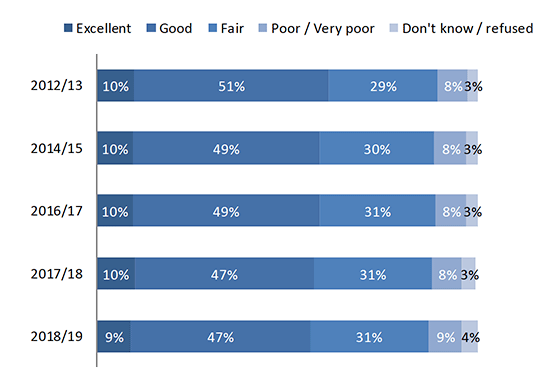
Base: All adults (2012/13: 12,050; 2014/15: 11,470; 2016/17: 5,570; 2017/18: 5,480; 2018/19: 5,540); Variable: QRATPOL.
In 2018/19, victims of crime were less likely than non-victims to say the police were doing a good or excellent job (50% compared with 56% respectively). Likewise, a smaller proportion of those living in the 15% most deprived areas of Scotland described the local police's performance as good or excellent compared to adults in the rest of Scotland (50% compared with 57% respectively).
Looking at this measure over time, there has been a decrease in the proportion saying the police are doing an excellent or good job across a range of demographic groups since 2012/13. Specifically, at a national level, confidence decreased among the following groups:
- people in both urban and rural areas
- both men and women
- people who were not a victim of crime in the year prior to interview
- people aged 45-59
- people aged 60 and over
Other than the category of those aged 60 and over (which has decreased from 64% in 2012/13 to 51% in 2018/19), all of the other decreases mentioned have been around 5 percentage points and are similar levels to the national average.
Further details of these changes in confidence levels over time can found in Annex table A1.15.
There was no change in the levels of confidence in the police for victims of crime or those living in the most deprived areas of Scotland between 2012/13 and 2018/19.
Since 2009/10, SCJS respondents have also been asked to what extent they agree that 'people in their area have a lot of confidence in the police'. In 2018/19, 42% of adults agreed with this statement, unchanged from 2009/10 but down from a peak of 49% in 2012/13. This result has been stable since 2014/15 – mirroring the trend in the overall police rating measure in recent years.
Taking these findings together, it would appear that in general people were more likely to personally say the police were doing an excellent or good job, than think that others in their local area would be confident in the police. Further research, such as a qualitative approach, could explore these differences.
How confident were people in the ability of the police?
This section considers public perceptions in the effectiveness of the police, by asking respondents how confident they were in the ability of the police in their local areas to undertake six particular components of work:
- prevent crime
- respond quickly to appropriate calls and information from the public
- deal with incidents as they occur
- investigate incidents after they occur
- solve crimes
- catch criminals
For convenience, these results are often referred to as 'effectiveness measures' below.
Overall, the public have confidence in the police, with levels remaining higher than the 2008/09 baseline. However, there has been a decreasing trend since police reform in 2013 across some measures.
Most adults in Scotland were confident in the ability of the police across the range of effectiveness measures in 2018/19, as shown in Figure 6.2, with at least three-fifths of adults saying they were very or fairly confident for five of the six indicators. Confidence in the ability of the police to carry out the six aspects of police work has increased since the SCJS first collected these data in 2008/09, as shown below. However, confidence was lower in 2018/19 compared to 2012/13 on four of the measures (with no change in the measures on solving crime and catching criminals).
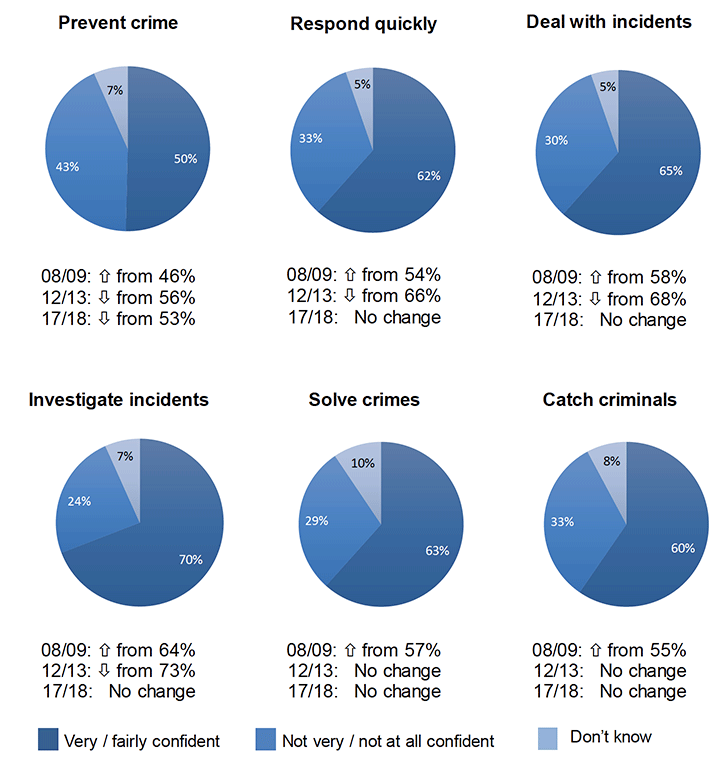
Base: All adults (5,540); Variables: QPOLCONF_01 – QPOLCONF_06
Looking more closely at the trends over time for each indicator reveals that generally confidence in the ability of the police:
- increased in the years between 2008/09 and 2012/13
- decreased marginally across some measures between 2012/13 and 2014/15 (but remained above the 2008/09 baseline)
- has since stabilised or fluctuated a little around the 2014/15 level
The only measure to show any change between 2017/18 and 2018/19 was confidence in the ability of the police to prevent crime, which fell from 53% to 50%. This aspect of policing has consistently shown the lowest level of confidence across the six measures over the years. This measure should continue to be monitored in the coming years as results have decreased from a peak of 57% in 2014/15, although they remain above the 2008/09 baseline of 46%.
Did the public feel the police conducted their work fairly and were engaged with their community?
In 2018/19 adults in Scotland were generally positive about the way the police in their local area carried out their work and engaged with the public.
As well as looking at confidence in the ability of the police, the SCJS explores whether respondents believe the police treat people fairly and with respect, and whether the service is focused on the issues which matter to particular communities.
Respondents were asked whether they agreed or disagreed with a series of statements about the police in their area, with adults in 2018/19 mostly providing positive responses or saying they did not have a strong view, as shown in Figure 6.3 below. These have been grouped into measures which can be considered to be related to perceptions of how engaged the police are with the community and how fair the police are when carrying out duties respectively (hereafter generally referred to as 'fair treatment' or 'fairness' and 'community engagement'). Overall, these findings suggest that largely people hold favourable views on the approach of their local police, and this is in line with the finding that the majority of adults are confident in the police and views on the effectiveness of the police are generally positive.
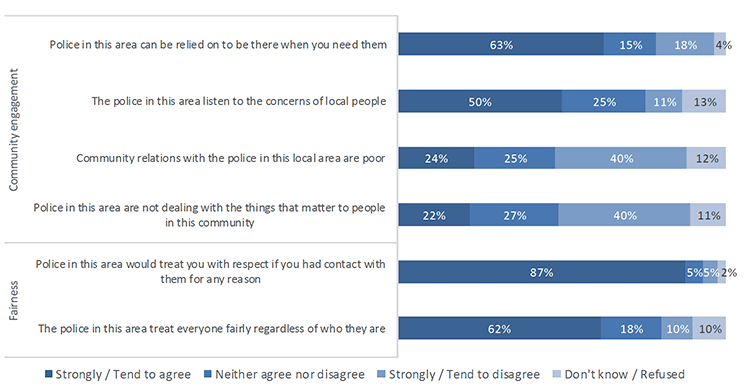
Base: Adults who are not a serving police officer, married to or living with serving police officer (5410); Variables: POLOPREL – POLOPCOM
Views on how fair and engaged the police are have generally improved since 2009/10, although perceptions on some elements of community engagement have worsened a little since 2012/13.
Compared to 2009/10 (when these questions were first included in the survey) the public held more positive views in 2018/19 across most of the above measures which examine perceptions of fair treatment and community engagement. Improvements generally occurred between 2009/10 and 2012/13, with more stability and short-term fluctuation shown in the years since then.
The SCJS finds that in 2018/19 adults in Scotland were more likely to believe that their local police:
- treat individuals fairly, and with respect
- focus on issues of importance to them
The section below presents these fair treatment and community engagement measures in turn.
Public confidence in the police to treat individuals fairly
Views on the two fair treatment measures have both improved since these questions were first asked in 2009/10[71] with:
- 87% in 2018/19 agreeing with the statement that the police would treat you with respect, up from 83% in 2009/10
- 62% in 2018/19 agreeing that the police treat everyone fairly regardless of who they are, up from 58% in 2009/10
These results can be seen in full in Annex table A1.22.
Public confidence in the police to engage with the community
Turning to community engagement measures[72], since their introduction in 2009/10 results on these measures have been generally positive. However, since 2012/13 some aspects of community engagement have shown trends which are worth monitoring. For example:
- the proportion of people who think that the police listen to the concerns of local people has fallen from 54% in 2012/13 to 50% in 2018/19; this is in line with the 2009/10 baseline
- there has been a small increase in the percentage of people who agree that community relations with the police are poor (from 22% in 2012/13 to 24% in 2018/19), although this remains lower than the 2009/10 baseline
Whilst there has been a small improvement in the proportion of people thinking that the police are not dealing with issues which matter to the community since 2012/13 (when 25% of people felt this way), just over one-fifth still thought this was the case in 2018/19 (22%).
These findings are particularly notable given that only 11% of respondents disagreed with the statement that 'the police in this area listen to the concerns of local people' – suggesting that views on different aspects of community engagement can be varied and complex.
These results also suggest that some aspects of community engagement should continue to be monitored into the future, although like the other measures of perceptions of the police, the picture remains positive in the wider and longer-term context. All indicators on aspects of fair treatment and community engagement showed no change between 2017/18 and 2018/19.
How did perceptions of the police vary amongst the population?
The SCJS enables us to examine how views on the ability of the police, their level of community engagement and fairness in their approach varied across the population according to demographic and geographic characteristics, as well as whether individuals had experienced crime or not in the year prior to interview. The section below explores results for selected breakdowns, with key results and additional breakdowns presented in more detail in the Annex tables (for effectiveness measures) and online data tables.
Whilst the majority of adults in 2018/19 generally held favourable views on the police across the range of indicators, those in deprived areas and victims of crime were often less positive.
Overall, in line with the national average, views on the police were positive amongst population sub-groups in 2018/19 across the range of effectiveness, community engagement and fairness measures.
However, notwithstanding the overall positive perceptions of the police, views in 2018/19 varied between those in the most deprived areas (compared to those living elsewhere) and victims of crime (compared to non-victims). These two groups held less positive opinions on the police across a selection of the metrics looking at effectiveness, community engagement and fairness. Significant differences are outlined in Figure 6.4 below, with all other measures showing no difference between these comparator groups.
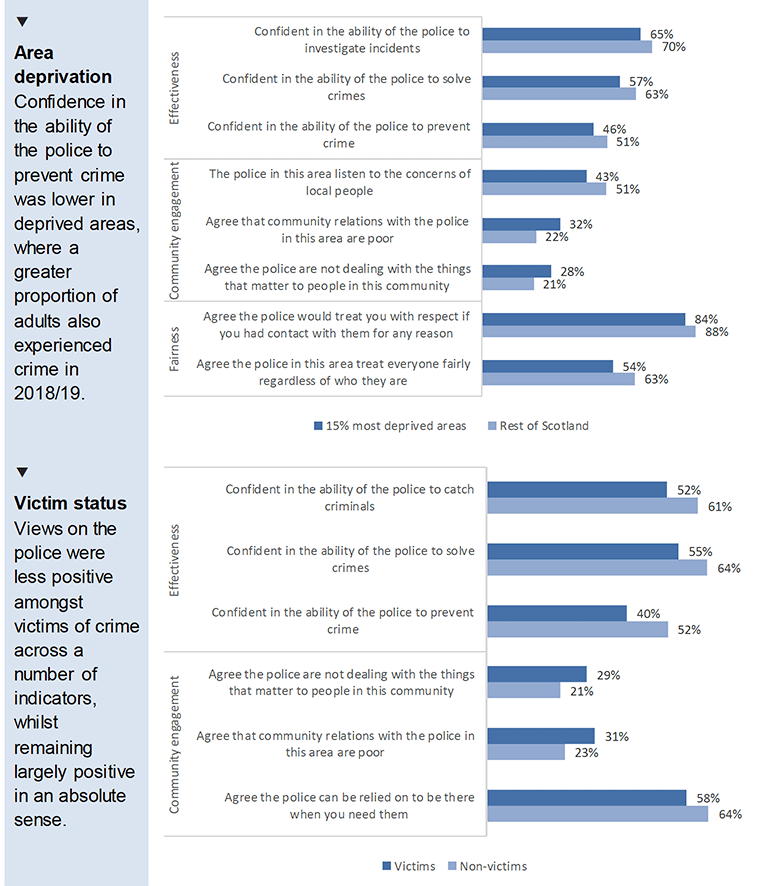
Base: Effectiveness: Victims (630); Non-victims (4,900); 15% most deprived areas (790); Rest of Scotland (4,750). Community engagement/fairness: Victims (610); Non-victims (4,800); 15% most deprived areas (770); Rest of Scotland (4,640). Variables: QPOLCONF_01 – QPOLCONF_06; POLOPREL – POLOPCOM
It is notable that confidence in the ability of the police amongst those living in the most deprived areas (who were more likely to have experienced crime in 2018/19) was lower in relation to the ability of the police to prevent crime.
Adults in the two youngest age categories were more likely to be confident in the police across effectiveness measures in comparison with adults aged 45-59 and 60 or over.
Looking at confidence in the police by age, 2018/19 reveals the two youngest categories (i.e. those aged 16 to 24 and 25 to 44) had higher levels of confidence across the six effectiveness measures than adults aged 45-59 and 60 or over. People aged 16 to 24 and 25 to 44 were also more likely to say the police were doing an excellent or good job.
Detailed breakdowns by age groups in 2018/19 and over time can be found in the online data tables.
Turning to views on fair treatment and community engagement by age, there is a less clear picture. For example:
- adults aged 16 to 24 were more confident in the ability of the police to be relied upon to be there when you need them (76% compared to 68% of those aged 25-44 years old, 56% of those aged 45-59 years old, and 58% of those aged 60 or over)
- 16 to 24 year olds were also more confident in the ability of the police to listen to the concerns of local people (58% compared to 51% of those aged 25-44 years old, 47% of those aged 45-59 years old, and 49% of those aged 60 or over)
- people aged 60 or over were more confident than all other age groups in the ability of the police to treat you with respect if you had contact with them for any reason (90% compared with 86% of those aged 16-24, 85% of those aged 25-44 years old, and 88% of those aged 45-59 years old)
There was no clear pattern in views when looking at results by rurality and gender.
While views across many indicators were fairly similar in urban and rural areas, those in urban areas had more confidence than those in rural areas in effectiveness of the police (see Figure 6.5 below).
By contrast, particular aspects of fairness and community relations were more positive in rural areas, also shown in Figure 6.5 below.
Additionally, it is worth noting that there was no difference between those in urban and rural areas in the proportions who thought the police were doing a good or excellent job in 2018/19 (55% and 56% respectively).
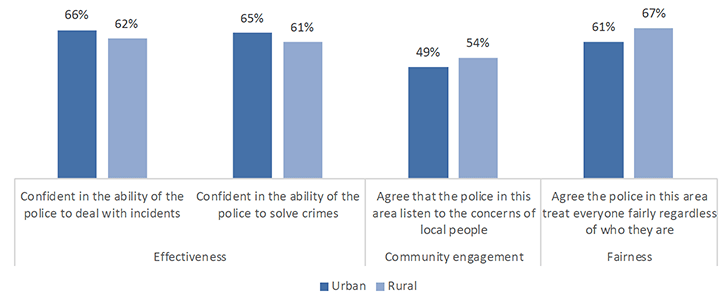
Base: Effectiveness: Urban (4,560); Rural (980). Community engagement/fairness: Urban (4,450); Rural (960). Variables: QPOLCONF_01 – QPOLCONF_06; POLOPREL – POLOPCOM
There were also differences across some of these measures between men and women, but the pattern was not consistent. In 2018/19, women were more likely than men to be confident across three measures exploring the perceived effectiveness of the police (respond quickly, solve crimes and catch criminals). On the other hand, men were more likely to think the police would treat you with respect if you had contact with them and they would treat everyone fairly regardless of who they are.
Perceptions of the police have improved amongst many population groups since 2008/09.
Looking at trends over time the SCJS finds that perceptions of the police have improved since 2008/09 (or 2009/10 where relevant) for many key groups in the population.
For instance, the proportion of adults who felt very or fairly confident in the ability of the police to take forward each of the six components of police work in terms of effectiveness was higher in 2018/19 compared to 2008/09 amongst: both men and women; people living in the most deprived areas of Scotland and adults living elsewhere; victims of crime and those who had not experienced crime. These results are shown in full in Annex Tables A1.16 to A1.21[73]. The tables also show that results have been broadly stable since 2017/18, with only a few significant changes.
Figure 6.6 provides a closer look at perceptions amongst people in the most deprived areas by way of example. It outlines how confidence in the ability of the police has increased over time between 2008/09 and 2018/19, although the apparent increase shown below in confidence in the ability of the police to prevent crime is not statistically significant.
Measures looking at perceptions of community engagement and fairness have also generally shown significant improvements in the most deprived areas of Scotland since 2009/10[74].
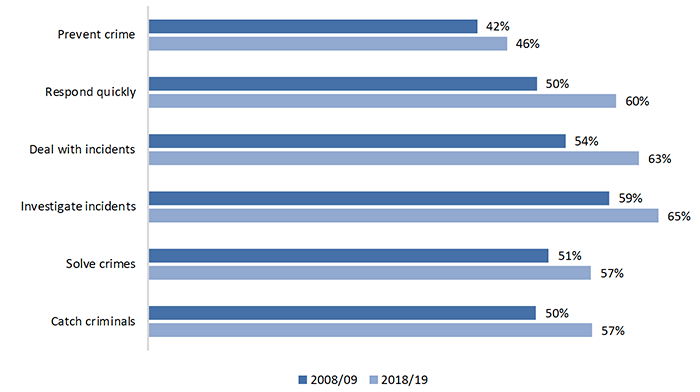
Base: Adults living in 15% most deprived areas (2008/09: 2,440; 2018/19: 790); Variables: QPOLCONF_01 – QPOLCONF_06
Note: the apparent increase in confidence in the ability of the police to prevent crime in Figure 6.6 is not statistically significant.
Confidence in the ability of the police in rural areas has not shown the same improvement as in urban areas since 2008/09.
Whilst the majority of people in urban and rural areas were positive about the police in 2018/19, perceptions in urban and rural areas have shown differing trends over the longer term – with views generally improving in urban areas, but showing more stability in rural locations overall. Table 6.1 below shows results from the six effectiveness measures in both rural and urban areas, comparing changes over time.
The full time-series showing fluctuations from year to year in results for urban and rural areas are shown in Annex tables A1.16 to A1.21.
Table 6.1: Confidence in the ability of the police in urban and rural areas
| Urban | Rural | |||
|---|---|---|---|---|
| Proportion of adults who were very or fairly confident in the police to: | 2018/19 | Change since 2008/09 |
2018/19 | Change since 2008/09 |
| Prevent crime | 50% | from 42% | 53% | from 48% |
| Respond quickly to appropriate calls and information from the public | 63% | from 54% | 61% | from 56% |
| Deal with incidents as they occur | 66% | from 57% | 62% | No change |
| Investigate incidents after they occur | 70% | from 63% | 68% | No change |
| Solve crimes | 62% | from 53% | 61% | No change |
| Catch criminals | 62% | from 54% | 59% | No change |
| Number of respondents | 4,560 | 980 | ||
Variables: QPOLCONF_01 – QPOLCONF_06
By contrast, looking at measures on perceptions of community engagement and fairness in both urban and rural areas these remained unchanged between 2009/10[75] and 2018/19.
What did the public think about the level of police presence locally?
The SCJS includes a series of questions which explore the public's views on the importance and awareness of police patrolling respondents' local area[76].
The proportion of adults aware of the police regularly patrolling their area continued to fall in 2018/19.
Whilst the vast majority (91%) of adults in 2018/19 considered it very or fairly important to have local police officers who know and patrol their local area, the proportion who said they were aware that their area was regularly patrolled[77] fell to 38% in 2018/19. As shown in Figure 6.7, this result is down from a peak of 56% in 2012/13 and 40% in 2017/18.
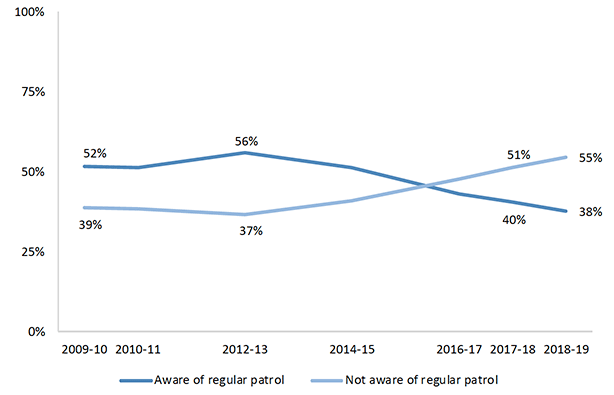
[IMAGES]
Base: Adults who are not a serving police officer, married to or living with serving police officer (2009/10: 3,890; 2010/11: 3,180; 2012/13: 11,520; 2014/15: 11,180; 2016/17: 5,420; 2017/18: 5,360; 2018/19: 5410); Variable: POLPATR
As in previous years, Table 6.2 shows that adults living in the 15% most deprived areas were more likely than those in the rest of Scotland to report being aware of their area being patrolled regularly.
Table 6.2: Public awareness of police patrolling in the local area
| Percentage of respondents aware of police patrol (inlcuding how patrolled) | 15% most deprived areas | Rest of Scotland |
|---|---|---|
| Yes | 48% | 36% |
| On foot | 20% | 9% |
| By bicycle | 6% | 3% |
| By car | 41% | 34% |
| No | 45% | 56% |
| Number of respondents | 790 | 4,750 |
Base: Adults who are not a serving police officer, married to or living with serving police officer; Variable: POLPATR
Note: results from 'don't know' responses are not included within this table but have been included within the analysis relating to public awareness of police patrolling in the local area
At a national level, amongst those aware of the police patrolling their area by foot or bike, just over a quarter (27%) reported noticing such activity at least every couple of days, if not daily. Around a further quarter (24%) said they had seen the police at least once a week.
There was no difference between urban and rural areas in the proportion of adults reporting awareness of regular police patrols.
In 2018/19 the population remained divided about whether the police presence in their area was sufficient.
When asked about whether they thought the local police presence was sufficient, 43% of adults in 2018/19 believed it was 'about right', while 51% said it was 'not enough'. Very few respondents typically report there is 'too much' of a police presence – for example, 0.6% in 2018/19.
The proportion of adults who felt the level of police presence was insufficient ('not enough') fell from 56% in 2009/10 to 46% in 2012/13, but has increased again in recent years whilst remaining below the 2009/10 baseline.
Those living in the 15% most deprived areas of Scotland were less likely to believe that the police presence in their local area was 'about right', with 38% feeling this way compared to 44% in the rest of Scotland. Likewise, victims of crime were less likely to be positive about the current level of presence (38% compared to 43% of non-victims).
Despite there being no difference in the level of awareness of regular police patrols between urban and rural areas, those in rural locations were more likely to feel that the level of police presence was 'about right' (49% compared to 42% in urban areas). This may suggest that rural communities have different experiences and expectations of local policing.
Opinions on the level of police presence are most commonly informed by personal experience of seeing the police, underlying perceptions of what patrolling should involve and views on the prevalence of crime.
At a national level, the most frequently cited reasons mentioned by those who thought that the level of police presence was insufficient were related to respondents not personally seeing the police, believing that there should be (and possibly previously were) more police around, and that they should patrol more regularly, particularly by foot rather than just by car.
In contrast, the most common reasons for saying the level of police presence was 'about right' related to a (perceived) lack of crime in the area, with some respondents also feeling reassured by seeing the police at the current regularity and being content with seeing them in cars.
How satisfied were people with their interactions with the police?
The majority of people who have come into contact with the police in recent years reflect positively on their experience.
As noted in this chapter's introduction, there has been a focus on the perceptions of the general public about policing. In this section, results from those who have had direct contact with the police are presented.
The SCJS explores experiences of contact respondents have had with the police in the last year. Follow-up questions to understand how individuals feel they were treated during their engagement are asked of respondents whose most recent contact with the police involved:
- reporting a crime
- contact through work
- being approached by the police while they carried out routine enquiries
- being questioned or searched
- reporting other matters
As with general attitudes towards the police, the quality of any contact with the police and individuals' perceptions of whether they have been treated appropriately are amongst the factors which are likely to influence the level of confidence held in the police.
In 2018/19, the majority of people were fairly positive about their engagement with the police in relation to their most recent contact with the service. For example:
- 94% said they were dealt with in a very or fairly polite manner[78]
- 88% felt they were treated fairly
- 73% believed the police showed as much interest as they should have in what respondents had to say
- 70% were very or quite satisfied with the way the police handled the matter
These results are consistent with previous years, showing no change from 2017/18.
Police Scotland also conduct a User Satisfaction Survey (USS) with a large number people who have contacted the police to report a crime or incident. Although results are not directly comparable, USS results in recent years have shown the majority of respondents are satisfied with the response received and that they had been treated fairly and with respect, similar to the SCJS. More information on results from the USS can be found: here (page 16).
Selected publications on factors that drive public confidence in the police
Scottish Crime and Justice Survey (2019),Questionnaire Development: Policing Reviewfor a concisesummary of how public confidence in the police is understood across relevant literature.
Bradford, B. and Myhill, A. (2015). Triggers of change to public confidence in the police and criminal justice system: Findings from the Crime Survey for England and Wales panel experiment. Criminology and Justice, 15(1), pp. 23-43.
Bradford, B., Jackson, J. and Stanko, E.A., (2009). Contact and confidence: Revisiting the impact of public encounters with the police. Policing & society, 19(1), pp. 20-46.
Stanko, E.A., Bradford, B. (2009). Beyond Measuring 'How good a job' Police are Doing: The MPS Model of Confidence in Policing. In Policing. Volume 3. Number 4, pp. 322-330.
Perceptions of the criminal justice system
The SCJS also collects information on public knowledge of and attitudes towards the criminal justice system in Scotland, as well as people's contact with different organisations operating within the system[79].
What did the public think about the criminal justice system in Scotland?
Consistent with previous years, the majority of adults in 2018/19 knew little about the criminal justice system but were fairly confident about its operation.
Consistent with previous SCJS results, in 2018/19 around three-quarters (76%) of adults said they did not know very much or anything at all about the criminal justice system. By contrast, only 3% said they knew a lot.
Regardless of their self-reported knowledge, respondents were asked about their confidence in the criminal justice system as a whole through a range of statements about the operation and performance of the system. As shown in Figure 6.8 below, the majority of people were either very or fairly confident about the delivery of the criminal justice system across a range of considerations.
For example, more than three-quarters of adults were confident that the system allows all those accused of crimes to get a fair trial and that everyone is able to access the justice system if required (both 76%).
However, less than half (45%) were confident about the efficiency of the system and that appropriate sentences are given which fit the crime (37% confident).
Notwithstanding wording changes in the latter measure in recent years, it is important to note that confidence in both these indicators has increased since they were first included in the survey. For example, in 2008/09, 35% were confident the system deals with cases promptly and efficiently, compared to 45% in 2018/19.
Likewise, in 2012/13, 32% were confident that the system gives punishments which fit the crime, compared to 39% in 2016/17. When the wording was changed to 'sentences' in 2017/18 the proportion of adults who were confident was 38%, with the 2018/19 finding showing no statistically significant difference from this figure. It is important to note that the specific wording used in this question does not directly confirm whether respondents who said they were not confident believe that sentences are too lenient or severe, which revised wording or a follow-up question would be required to confirm. This could be considered for the SCJS questionnaire in future.
More generally, Figure 6.8 shows the proportions who said they were confident or not confident in the criminal justice system, as well as those who responded don't know – which represents a sizeable minority of respondents for some questions.
The full time-series showing fluctuations from year to year in results for confidence in the justice system are shown in Annex table A1.23.
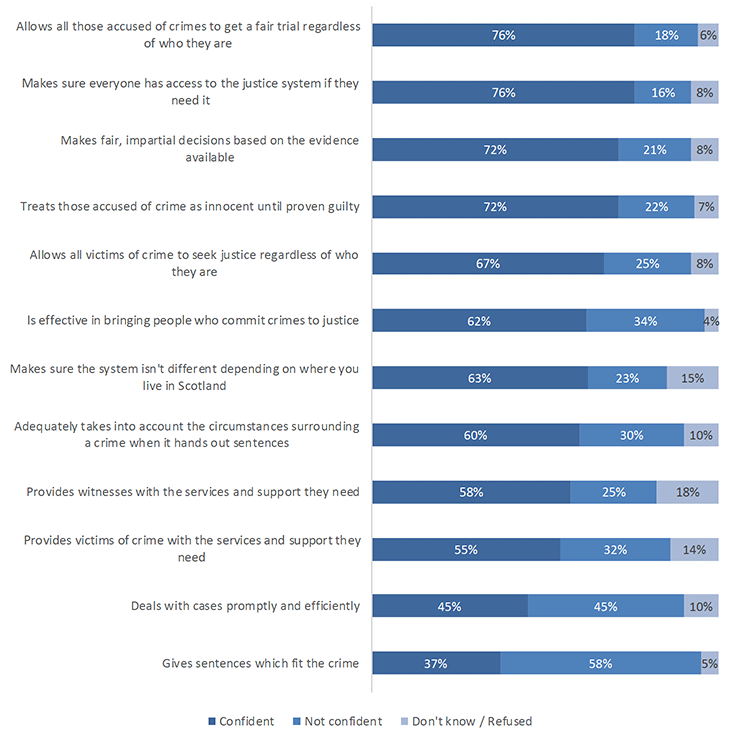
Base: All adults (5,540); Variables: QDCONF_01 – QDCONF_15
As with the examples outlined above, it shows that generally confidence in the criminal justice system was stronger across the range of measures in 2018/19 than it was the first time each question was asked[80].
The level of confidence that the system makes sure everyone has access to the justice system if they need it was adopted as a National Indicator in the Scottish Government's refreshed National Performance Framework in 2018. The proportion of adults confident in this element of the justice system has increased from 70% in 2008/09 to 76% in 2018/19, with the latest result unchanged from the position in 2017/18.
Older adults and those living in the most deprived areas of Scotland were generally less confident in the justice system in 2018/19.
For most of the measures exploring views on the justice system, younger adults (those aged 16 to 24) were more likely to be confident than those aged 60 and over. For example, 70% of those aged 16 to 24 were confident that the system is not different depending on where you live, in comparison to 59% of those aged 60 or over.
Across about half of the measures, those living in the 15% most deprived areas of Scotland (compared to those living elsewhere) were less likely to be confident. For instance, 61% of adults living in the 15% most deprived areas were confident that the justice system makes fair, impartial decisions based on the evidence available compared to 74% of those living elsewhere.
In 2018/19, victims of crime generally felt less confident in the justice system in comparison to non-victims.
In 2018/19, there were differences between the levels of confidence in the criminal justice system amongst victims of crime compared to non-victims. Victims had less confidence than non-victims across the majority of SCJS measures. For example:
- 57% of victims were confident that the system is effective in bringing people who commit crimes to justice, compared to 63% of non-victims
- 40% of victims were confident that the system deals with cases promptly and efficiently, compared to 45% of non-victims
- 66% of victims were confident that the system makes fair and impartial decisions based on the evidence available, compared with 73% of non-victims
These results align with findings from previous years which have tended to detect lower confidence in the criminal justice system amongst victims of crime compared to non-victims. A notable exception were the 2017/18 results which showed little variation between these two groups and their confidence in the justice system.
How did the public view the prison system and community sentences?
The SCJS also gathers information on attitudes towards prisons and community sentences to understand what the public thinks about processes to sentence and rehabilitate offenders. The specific wording used over time has changed in a number of the questions on this topic, limiting the ability to examine some trends over time[81].
In addition, it is important to note that questions on attitudes towards prisons and community sentences within the SCJS are asked without reference to specific crime circumstances or offender backgrounds which may influence opinions about what constitutes a suitable sentence or approach. For example, findings from a Scottish Sentencing Council (2019) report on Public Perceptions of Sentencing showed how individuals' awareness of mitigating circumstances or specific offences can shape how punitive a respondent is when asked about sentencing[82].
The public generally thought that prisons should provide support to help prisoners address problem behaviours and integrate with the community.
The SCJS has previously sought to understand the public's confidence in the effectiveness of prisons, however these questions were updated with effect from 2017/18 to now explore attitudes about what adults in Scotland believe prisons should do.
Table 6.3 shows that in 2018/19 the vast majority of adults agreed that prisons should provide support to prisoners to help them address any underlying issues, reduce re-offending and help them fit back into the community. Just over half (52%) agreed that only those who commit the most serious crimes should be put in prison. These results showed no change compared to 2017/18.
Table 6.3: Attitudes towards the role of prisons
| Proportion of adults | Strongly/Slightly agree | Neither agree nor disagree | Strongly/Slightly disagree | Don't know / Refused |
|---|---|---|---|---|
| Only those who have committed the most serious crimes should be put in prison | 52% | 10% | 36% | 1% |
| Prisons should help prisoners change their behaviour rather than just punish them | 90% | 4% | 5% | 1% |
| Prisons should provide support in order to prevent people committing more crime | 92% | 4% | 3% | 1% |
| Prisons should work with other organisations in the community to help prisoners fit back into the community | 89% | 6% | 4% | 1% |
| Homeless prisoners should be helped to find a place to live after they leave prison | 89% | 6% | 4% | 1% |
Base: All adults (1,380); Variables: QPRIS3_01 – QPRIS3_05
Adults were generally supportive of community sentences, although almost a quarter believed that they put the public at risk of crime.
The current questions on whether respondents agreed or disagreed with a series of statements relating to the purpose and operation of community sentences were developed in 2017/18. Results in 2018/19 show that:
- the vast majority of adults (90%) believed that people serving community sentences should be given support (such as help with addiction or mental health problems, or numeracy or literacy difficulties) to reduce the likelihood of them committing more crime in the future
- most people (84%) believed that people helping their community as part of a community sentence is an appropriate response for a minor offence rather than a short prison sentence
- almost three-quarters (77%) believed that people who do not comply with the terms of their community sentence will be held to account
- around a quarter (23%) of adults believed that people who serve community sentences put the public at risk of crime
Relatively few people were aware of unpaid work placements being carried out in their local area as part of community sentences.
Respondents were also asked about their awareness and perceptions of unpaid work placements which can be completed as part of a community sentence. Just 14% adults were aware of unpaid work placements being carried out in their area, although amongst those who were aware of them, 71% agreed that their area had benefitted. Further research could explore public awareness of unpaid work placements.
Contact
Email: scjs@gov.scot
There is a problem
Thanks for your feedback